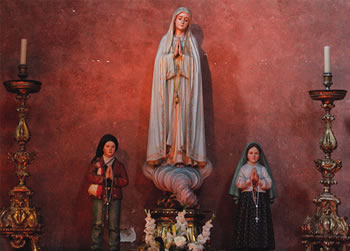Mary for Today: Mary in Culture (8)

By Br Kieran Fenn FMS
Apparitions within Culture
The phenomenon of Marian apparitions or visions is a culturally specific feature understandable to Mediterranean people or those in contact with Mediterranean cultural scripts. In visionary form, the mother of Jesus has been part and parcel of Mediterranean living from time immemorial. At times such visions lasted only a few minutes, at others they were intermittent over a period of days, weeks or even years. Throughout European Christendom, particularly in rural areas, such visions, especially of Mary, have occurred from at least the fifth century to the present. Historically and traditionally, visions and appearances have been effective ways to consecrate a place as holy -- to set up a shrine. They are likewise efficient ways for towns or regions to obtain the latest word from heaven on how to avoid collective disasters, whether plague, or drought, or economic disasters. They also help localities manage in times of warfare.
‘The hunger for direct messages from heaven in visionary form has not been appeased, and the continuing faith with which such manifestations are treated still forms one of the most precise images of the Catholic Church’s anxiety to renew intimacy with the Godhead’ (Marina Warner). After the councils of the 4th and 5th centuries, the subjects of the Holy Roman Empire knew that Jesus of Nazareth is, in fact, God and his mother, Mary of Nazareth, is, in fact, the Mother of God. Every Mediterranean knows that a son can refuse his mother nothing, hence it was quite logical for Mediterraneans to approach their deity by means of his mother. Mary then took on the common role of patron, functioning as Mediterranean maternal patron mediating access to her son.
Common Patterns of Apparitions
There is a distinction between visions and apparitions; visions take place in the mind of a person; apparitions are external events with often a large number of seers or witnesses. Visions tend to point to a holy person; apparitions to a holy place. At the outset there is always some crisis experience that calls for a private experience of God. Examples are the experience of Juan Diego and Our Lady of Guadalupe; troops and Our Lady of the Rosary at the Battle of Vienna; children and Our Lady of Fatima. A private ecstatic experience then leads to a communal experience that is enmeshed with some sacred object (e.g. Juan Diego’s cloak; the rosary; first Saturdays).

Our Lady of Fatima and the Children
A second step involved the need to assert Roman-focused Christianity against heretics (in Mexico, of Rome and the local bishops over Royalists; of Europe over the Turks; of Western Christianity over atheistic Communism). The vision experience and sacred object then is related to some site (the shrine church now in suburban Mexico City; a votive church in Rome; a shrine at Fatima).
The third step is the use of a religious practice as a battle standard: a war banner, the standard of Our Lady of los Remedios of Cortes against the Royalists; Christianity against the Turks, as private ecstatic experience becomes a communal experience as a whole people is blessed. The apparition becomes related to the nation (patroness of Mexico and later of the Americas; protectress of Europe; patroness of Europe against godless Communism). A social cause is then tied in (Indian rights; Mary spoke in the native language rather than Spanish; European unity; Capitalism or Socialism). Thanks to the apparition people find themselves now filled with power and moral authority within their world setting.
Past and Future
To find out the social matrix of Marian visions in Mediterranean Europe or annexed areas, all one has to do is figure out the opponents of the church at the time. As a rule, visions and apparitions of Mary (and others) proliferate during periods of crisis. The newest role for such visions and appearances may well be found in those distressed by changes in Church policy, a slackening of Church discipline, and a softened attitude towards Communism. Problems in Church policy and discipline may well be the fuel for some time to come.
Source:
Malina, Bruce J., From Isis to Medjugorje: Why Apparitions?, Biblical Theology Bulletin, Vol.20
 Entries(RSS)
Entries(RSS)